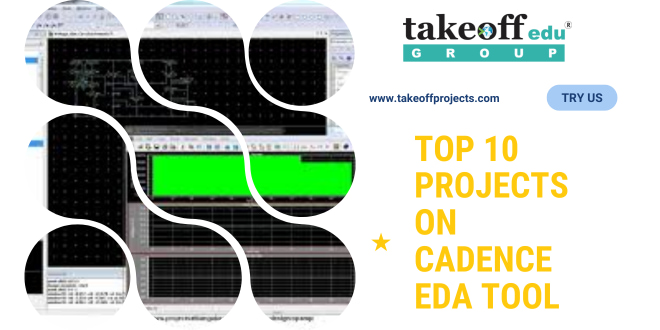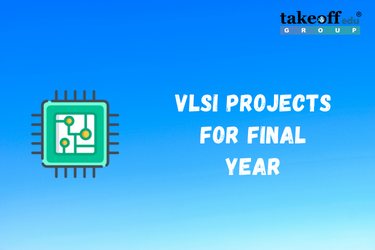The Electronic Design Automation (EDA) software designed by the US based engineering and software company known as Cadence Design Systems is popularly known as Cadence EDA tool. It consists of a collection of tools for creating semiconductor devices including chips, hardware, and software. Circuits and designs are created and evaluated in EDA’s simulated environment before being implemented in the real world. In the backdrop of the rapid growth of AI (i.e., Artificial Intelligence), the EDA tool has advanced enormously.
The top 10 projects on Cadence EDA tool to learn from and put their talents to the test are as follows:
1. High-Speed and Area-Efficient Scalable N-bit Digital Comparator
In this research, a high-speed, low-power N-bit digital comparator with efficient use of area is presented. There are two distinct modules in the suggested comparator structure. The CEM (i.e., Comparative Evaluation Module) is the first module, and the FM (i.e., Final Module) is the second.
The regular structure of repeating logic cells utilized for constructing parallel prefix tree structure is a component of CEM, regardless of the input bit widths. On the basis of the CEM’s findings, the FM certifies the final comparison. Using 180nm technology, Cadence Virtuoso is used to implement the design.
Projects on Cadence EDA tool will suitably reshape and alter your designing career. Cadence EDA is considered to be very important tool while designing the semiconductors. It’s a crucial instrument for reliability testing and ensuring the accuracy of the design under a variety of circumstances. Designing quickly is necessary due to the growing client expectations.
2. A Unified NVRAM and TRNG in Standard CMOS Technology
Several keys for device authentication and cryptography are provided by the TRNG (i.e., True Random Number Generator). The complexity and size of the implementation increase since the TRNG is typically incorporated into the systems as a separate module.
In order to use the key produced by the TRNG for various purposes, the system also has to store it in non-volatile memory. Nevertheless, using a NVRAM (i.e., Non-Volatile Random Access Memory) requires extra technological qualities that are either unavailable or costly.
On a 45nm standard CMOS process, this prototype showcases a unified NVRAM-TRNG. Additional circuits are not required for the random number generation mode in the unified implementation.
Using a high voltage transistor, the differential NVRAM bit cell resists non-volatile memory application. Using CADENCE VIRTUOSO simulation, the suggested design has been tested.
Projects on Cadence EDA tool will suitably reshape and alter your designing career. Cadence EDA is considered to be very important tool while designing the semiconductors. It’s a crucial instrument for reliability testing and ensuring the accuracy of the design under a variety of circumstances. Designing quickly is necessary due to the growing client expectations.
3. Data Retention based Low Leakage Power TCAM for Network Packet Routing
To lessen the leakage power squandered in the TCAM memory, a novel state-preserved approach called DR-TCAM (i.e., Data Retention based TCAM) is developed in this study. Due to its superior lookup performance, the TCAM (i.e., Ternary Content Addressable Memory) is frequently employed in routing tables.
TCAM’s power consumption would be substantial, though, if there were a lot of transistors. In order to lessen the TCAM leakage power, the DR-TCAM may dynamically change the power supply of the mask cells based on the continuous characteristic of the mask data.
In particular, the mask data in the DR-TCAM wouldn’t be lost. The simulation findings demonstrate that the DR-TCAM outperforms cutting-edge works. The DR-TCAM wastes less power than the conventional TCAM system does. Using Cadence Virtuoso and 180nm technology, the desired design was realized.
4. A Partially Static High Frequency 18T Hybrid Topological Flip-Flop Design for Low Power Application
In this study, a Flip-Flop with a new layout and fewer transistors is shown. Three configurations, including topological, logical, and adaptive coupling approaches, support this structure.
Logic based on complementary pass transistors was used to construct this structure. GPDK library files are used to emulate this innovative architecture in cadence virtuoso.
Projects on Cadence EDA tool will suitably reshape and alter your designing career. Cadence EDA is considered to be very important tool while designing the semiconductors. It’s a crucial instrument for reliability testing and ensuring the accuracy of the design under a variety of circumstances. Designing quickly is necessary due to the growing client expectations.
5. A Novel Clock Gating Approach for the Design of Low-Power Linear Feedback Shift Registers
In this study, a novel LFSR design based on a gated clock method is presented. As is widely known, one of the low power strategies is the clock gating strategy. This clock gating is also created in a different arrangement here.
The LFSR structure receives a clock signal from a different logic that is applied to the gated clock generation. With the appropriate library files, cadence is used to design and simulate this entire architecture.
Projects on Cadence EDA tool will suitably reshape and alter your designing career. Cadence EDA is considered to be very important tool while designing the semiconductors. It’s a crucial instrument for reliability testing and ensuring the accuracy of the design under a variety of circumstances. Designing quickly is necessary due to the growing client expectations.
6. An Accurate Low-Power Power-on-Reset Circuit in 55-nm CMOS Technology
An accurate low-power power-on-reset circuit is suggested in this paper. A low-power design based on current reference and current comparator is suggested in order to obtain a precise trip-voltage with little overhead.
The sub-threshold currents of many native NMOS transistors are primarily responsible for supplying the reference current in the proposed power-on-reset circuit, and a stable hysteresis window may be created by altering the number of enabled native NMOS transistors. Using a 45nm GPDK library file, the complete design is simulated in Cadence Virtuoso.
Projects on Cadence EDA tool will suitably reshape and alter your designing career. Cadence EDA is considered to be very important tool while designing the semiconductors. It’s a crucial instrument for reliability testing and ensuring the accuracy of the design under a variety of circumstances. Designing quickly is necessary due to the growing client expectations.
7. An Efficient and High-Speed Overlap-Free Karatsuba-Based Finite-Field Multiplier for FGPA Implementation
The slowest and most space-intensive process in ECC systems is polynomial multiplication. The FPGA (i.e., Field-Programmable Gate Array) implementation of finite field multipliers for ECC is proposed in this paper as a unique hardware design.
Performance metrics were established when the proposed hardware was built on multiple FPGA devices for varied operand sizes. The efficiency of the design was demonstrated by the suggested method’s decreased combinational delay and area-delay product when compared to state-of-the-art works.
Projects on Cadence EDA tool will suitably reshape and alter your designing career. Cadence EDA is considered to be very important tool while designing the semiconductors. It’s a crucial instrument for reliability testing and ensuring the accuracy of the design under a variety of circumstances. Designing quickly is necessary due to the growing client expectations.
8. A High-Performance Core Micro-Architecture Based on RISC-V ISA for Low Power Applications
This project has a high-performance microarchitecture based on the RISC-V ISA. RISC-V Instruction Set Architecture serves as the foundation for this microarchitecture (ISA).
The four-step pipeline design of the RISC V that is being suggested here uses extremely simple components to provide the greatest results. This design's dynamic power consumption is superior to that of the ARM Cortex-M3 and Cortex-M4, as well as lower than that of many other designs.
The outcomes demonstrate that this core can outperform a large number of currently available commercial and open-source cores. Using Cadence EDA, the efficacy of the suggested technique is generated and simulated.
Projects on Cadence EDA tool will suitably reshape and alter your designing career. Cadence EDA is considered to be very important tool while designing the semiconductors. It’s a crucial instrument for reliability testing and ensuring the accuracy of the design under a variety of circumstances. Designing quickly is necessary due to the growing client expectations.
9. Design of Two Stage Operational Amplifier and Implementation of Flash ADC
Flash Analog to Digital Converter with 3-bit Resolution is implemented in this article. Flash ADC’s main issue is that as the number of resolution bits rises, the area of the circuit as well as its power consumption rise.
The use of portable, long-lasting battery digital systems is advocated. Creating apps with lower power requirements is the only way to do this. By improving the encoder circuitry, we primarily focused on reducing the ADC’s power consumption in this research.
Cadence Virtuoso tools utilizing 180nm technology are used to implement the complete design. Calculations and comparisons are made for Flash ADC performance metrics including latency and average power.
Projects on Cadence EDA tool will suitably reshape and alter your designing career. Cadence EDA is considered to be very important tool while designing the semiconductors. It’s a crucial instrument for reliability testing and ensuring the accuracy of the design under a variety of circumstances. Designing quickly is necessary due to the growing client expectations.
10. A Low-Power High-Speed Sense-Amplifier-Based Flip-Flop in 55 nm MTCMOS
Low-power, high-speed operation can be accomplished with a SAFF (i.e., Sensing Amplifier based Flip Flop). The power and latency of the flip-flop are significantly decreased by using a new sense-amplifier stage as well as a new single-ended latch stage. By implementing MTCMOS optimization, the proposed SAFF may enable low voltage operation. The suggested SAFF power and delay are less powerful than those of the current MSFF (i.e., Master Slave Flip Flop).
The size of the suggested flip-flop decreases, and the power-delay-product of the proposed SAFF is better than that of the traditional SAFF and MSFF. As a result, the proposed SAFF may operate reliably at low power supply voltages. With Cadence Virtuoso, the proposed design is implemented using 45nm technology. By adopting this method, we may provide 1 LVT and yet receive the desired output.
Projects on Cadence EDA tool will suitably reshape and alter your designing career. Cadence EDA is considered to be very important tool while designing the semiconductors. It’s a crucial instrument for reliability testing and ensuring the accuracy of the design under a variety of circumstances. Designing quickly is necessary due to the growing client expectations.

 Design and Analysis of Multi-Protocol Conversion Unit for SPI, I2C and UART
Design and Analysis of Multi-Protocol Conversion Unit for SPI, I2C and UART  Design of Polar Codes in 5G New Radio
Design of Polar Codes in 5G New Radio  Design & Study the Performance of CMOS Based Ring Oscillator for 5G Mobile Communication
Design & Study the Performance of CMOS Based Ring Oscillator for 5G Mobile Communication  Top IEEE VLSI Engineering Projects For Final Year Students with Source Code
Top IEEE VLSI Engineering Projects For Final Year Students with Source Code  Best VLSI Projects for ECE Students
Best VLSI Projects for ECE Students  Top 7 Transistor Logic Projects for Engineering
Top 7 Transistor Logic Projects for Engineering  Top 10 Low Power VLSI Projects
Top 10 Low Power VLSI Projects  Top 5 Nano Technology Projects using VLSI
Top 5 Nano Technology Projects using VLSI  Top 6 Communications Projects for Students
Top 6 Communications Projects for Students  Top 7 Projects on DSP Core
Top 7 Projects on DSP Core  Top 5 Projects on Arithmetic Core
Top 5 Projects on Arithmetic Core  Top 7 Projects on Finite State Machines
Top 7 Projects on Finite State Machines  FPGA Final Year Projects for Electronics Students
FPGA Final Year Projects for Electronics Students  Verilog Projects for ECE
Verilog Projects for ECE  VLSI Project Ideas for Engineering
VLSI Project Ideas for Engineering  VLSI Mini Projects for ECE Department Students
VLSI Mini Projects for ECE Department Students  VLSI Projects for Final Year
VLSI Projects for Final Year 
 Paper Publishing
Paper Publishing


